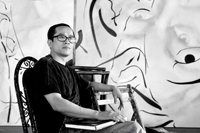We Have Launched Our New Website
http://www.tamadaprojectscorporation.com/
Pu Jie
works of art

portrait
Pu Jie (born 1959 in Shanghai)
The extraordinarily overheated Chinese art scene skipped over the modern era and spilled right over into the present without warning. Chinese contemporary art, which is said to date from 1985, slipped through a series of dramatic upheavals, such as the Tiananmen Square incident, while opening up the way to modernity. Against a backdrop of extreme social conditions characterized by an imbalance between economic development and personal freedom, coupled with an immature art market, excessive speculation in China’s art market took root, creating a bubble that has now burst. The inexperienced Chinese and Asian markets, with their tenuous understanding of art as investment, led to the manipulation of many artists through a game of money and the demise of the art bubble.
Pu Jie, however, draws a clear distinction between himself and most other Beijing artists who were lured by easy money, devoting himself to an artistic practice centered on his own individual worldview. He depicts a social structure that wavers between China’s past history and its present-day contemporary developments, condensing his unique insights onto his canvases.
Focusing on the urban context of the city of Shanghai, Pu Jie’s paintings portray stories of contemporary residents of the city who live in the shadow of China’s newly emerging histories.
Installed in a vast 500m2 space with ceilings measuring 4.5m high, this exhibition gives viewers an introduction to Pu Jie’s painterly world, focusing mainly on his new large-scale works. Also opening on September 24 at the Beijing Today Art Museum is a solo show by Pu Jie that takes into account its continuity with this exhibition.